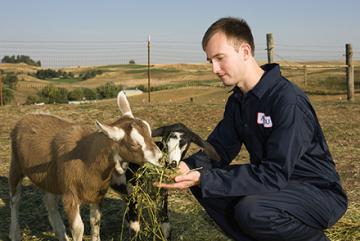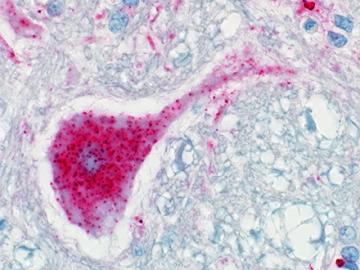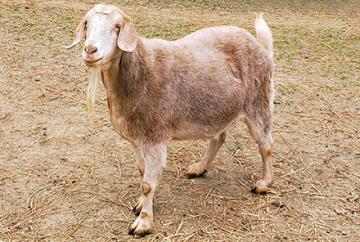Wiping Out Scrapie in Goats, the Genetic Way

ARS Geneticist Stephen White studies goats with a version of the prion gene that has conferred increased resistance to scrapie. (Peggy Greb, D1363-3)
More consumers are developing a taste for goat cheese, milk, and meat as they become aware of the high protein and great taste of these products. While U.S. goat producers are enjoying this steady trend, they remain focused on keeping their animals healthy, especially from scrapie—a fatal brain disease that affects goats and sheep.
“The goat industry is one of the fastest growing animal industries in agriculture,” says Stephen White, an Agricultural Research Service (ARS) geneticist. “Not too many years ago, there were only a few hundred thousand goats in the country.” But in January 2018, goats and kids totaled 2.62 million head.
Meat and dairy are the biggest markets, followed by mohair, but goats serve in other unique capacities, says ARS veterinary medical officer David Schneider. Goats are being used to manage weedy areas along highways, get rid of kudzu in the Southeast, and even mow lawns. They’re also used as pack animals to carry supplies through rugged areas.
For any of these businesses, a single outbreak of scrapie could be devastating.
There is no cure or treatment for scrapie, which is in the same family—transmissible spongiform encephalopathies (TSEs) or prion diseases—as mad cow disease. TSEs are rare degenerative brain disorders characterized by tiny holes that give the brain a “spongy” appearance.
Most often scrapie is transmitted through birth fluids to other goats and sheep, and it can remain infectious in the environment for many years. It was first recognized in sheep in Great Britain and other European countries more than 250 years ago and was first diagnosed in U.S. sheep in 1947 in a Michigan flock.
All animals that get scrapie die. But there is good news from ARS. White and Schneider, who both work at ARS’s Animal Disease Research Unit in Pullman, Washington, are the first to demonstrate by infectious disease challenge that goats with the S146 allele (a different form of a gene) are less susceptible to scrapie over a usual goat lifetime. They also tested the K222 allele in goats. Their research shows that goats with one copy of either the S146 or K222 allele did not develop scrapie after being challenged with infection at birth. The study was published in The Veterinary Journal in 2018.
“Commercial goats raised for either meat or milk age out of herd participation as milkers, dams of commercial offspring, or as sires by around 6 years of age,” White says. In this ongoing ARS research, goats with the resistance alleles have lived beyond this commercial lifetime—up to 7½ years—with no clinical disease and without getting sick.

Above is a micrograph image of a neuron within the brain of a goat with scrapie disease. The red staining demonstrates the presence of a misfolded prion protein that has accumulated in the neuron and which is a diagnostic hallmark of scrapie infection. (David Schneider, D4199-1)
On the Road to Eradication
The only countries considered to be scrapie free are Australia and New Zealand. Currently, if one goat is diagnosed with scrapie on a U.S. farm, all goats are quarantined for life or euthanized. “You couldn’t restock your operation with any susceptible animal,” White says. “The farmer’s operation would be over.”
This research is good news for both goat and sheep producers because it could help with eradication efforts. Before U.S. producers can take advantage of import and export markets, scrapie must be eradicated from the United States and meet the World Organisation for Animal Health (OIE) criteria for disease freedom.
“I think for the sheep industry alone, that’s about $10 to $20 million annually in lost revenue,” Schneider says.
The U.S. Department of Agriculture’s Animal and Plant Health Inspection Service (APHIS) heads the National Scrapie Eradication Program. The agency reports that the prevalence of scrapie has decreased significantly since 2002 through eradication efforts. “According to OIE rules, to be declared free of scrapie a country must conduct extensive surveillance for the disease and have had no scrapie cases for 7 years,” Schneider says.
In sheep, genetic resistance was discovered years ago. A test was then developed to allow U.S. sheep producers to test flocks and breed for the resistance allele. Now if there’s a scrapie outbreak on a farm, sheep that have the resistant genotype do not have to be quarantine or euthanized.
“The goat industry is hoping that APHIS will recognize the S146 and K222 genetic alleles and give the resistance goats the same ‘get out of jail card’ that sheep have,” White says.
In For the Long Haul
In 2007, White and Schneider started their study by challenging goat kids at birth with a mega dose of scrapie. The ongoing study consists of three genotype groups: goats with the protective S146 allele, goats with the K222 allele, and a control group with the common U.S. goat allele.
Most of the goats with the S146 or K222 allele lived a very long time and did not contract scrapie. Those that died were euthanized due to other natural causes. In contrast, all animals in the control group got scrapie within 2 years.
The S146 and K222 alleles had previously been associated with scrapie resistance in goats, but resistance to challenge had not been scientifically demonstrated, White says. “We’re the only ones, to our knowledge, testing these alleles for scrapie resistance to challenge with scrapie from anywhere in the Western Hemisphere. Also, our research is one of the longest running studies,” he adds.
In 2016, the U.S. Animal Health Association passed a resolution declaring that the evidence for these two alleles is compelling and should be incorporated into the scrapie eradication program, White says. Last year, a European Food Safety Authority panel of scrapie experts determined that there was enough evidence for the two alleles, plus a third known as D146, to be considered resistance alleles for classical scrapie in goats. The panel, which cited ARS research, concluded that these are resistance alleles and recommended they be used in scrapie control and eradication programs.

The genotype of this goat is proving to confer strong resistance to infection by scrapie prions. This goat remains healthy more than 10 years after exposure to this contagious fatal brain disease of goats and sheep. (David Schneider, D4200-1)
Testing Goats for Genetic Resistance
A DNA test was developed to identify animals with the S146 and K222 alleles and became commercially available in 2018. ARS scientists did not develop the test, but they played a major role in making sure it worked and helping to get it to the goat industry.
This ARS research is a definitive demonstration of goat scrapie resistance, Schneider says. It’s important to farmers, their networks, the goat and sheep industries, and other countries with goat scrapie problems.
“We have a long-time cooperation with the Canadian Food Inspection Agency,” Schneider adds. “We’ve been asked to help them with their in-house testing so they can apply the data to their scrapie eradication program.”
Scientists continue to study the goats in the project to find out how long they’ll live. “This is ARS making an impact—serving a role in long-term experiments that only ARS can—and it’s happening now,” Schneider says.—By Sandra Avant, formerly with ARS Office of Communications.

